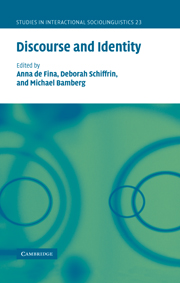Book contents
- Frontmatter
- Contents
- List of contributors
- Introduction
- Part I Overview: theory, method and analysis
- Part II Private and public identities: constructing who we are
- Editors' introduction
- 5 Identity à la carte: you are what you eat
- 6 Workplace narratives, professional identity and relational practice
- 7 Identity and personal/institutional relations: people and tragedy in a health insurance customer service
- 8 The discursive construction of teacher identities in a research interview
- 9 Becoming a mother after DES: intensive mothering in spite of it all
- Part III The gendered self: becoming and being a man
- Part IV The in-between self: negotiating person and place
- References
- index
8 - The discursive construction of teacher identities in a research interview
Published online by Cambridge University Press: 09 November 2009
- Frontmatter
- Contents
- List of contributors
- Introduction
- Part I Overview: theory, method and analysis
- Part II Private and public identities: constructing who we are
- Editors' introduction
- 5 Identity à la carte: you are what you eat
- 6 Workplace narratives, professional identity and relational practice
- 7 Identity and personal/institutional relations: people and tragedy in a health insurance customer service
- 8 The discursive construction of teacher identities in a research interview
- 9 Becoming a mother after DES: intensive mothering in spite of it all
- Part III The gendered self: becoming and being a man
- Part IV The in-between self: negotiating person and place
- References
- index
Summary
Introduction
Contemporary approaches view identity as a discursive construction that can be conceptualized further through a number of different data analysis frameworks. In relation to the understanding of teacher identities, the more familiar analytical approach has been generated from different versions of critical discourse analysis. Accordingly, the intention is to explore teacher talk as a space for the articulation and the repression of “voice” (Bloomfield 2000; Britzman 1992; Ellsworth 1989; McWilliam 1994). This can be considered as a “top-down” approach because the voices expressed and withheld – in interview talk, for example – are embedded in the wider ideologies and discourses of power that constitute educational and other cultural institutions. From this perspective identity is represented and shaped through the social and discursive practices that are available to individuals and groups at particular moments. Consequently, as members of particular discourses, individuals are positioned to speak, think and act in particular ways and are able to take up or refuse that positioning (Davies and Harré 1990; Gee 1996).
A much less familiar approach to teacher identity analysis is generated from ethnomethodology and conversation analysis (Baker 1983, 1984; Johnson 2002a, 2002b; Paoletti 2000, 2001, 2002). Using this “bottom-up” approach, researchers have become engaged in conceptualizing identity as “the set of verbal practices through which persons assemble and display who they are while in the presence of, and in interaction with, others” (Hadden and Lester 1978: 331).
- Type
- Chapter
- Information
- Discourse and Identity , pp. 213 - 232Publisher: Cambridge University PressPrint publication year: 2006
- 15
- Cited by



